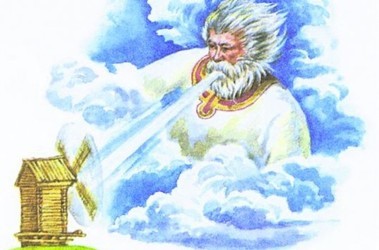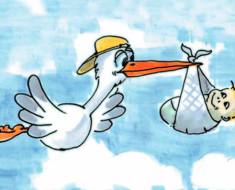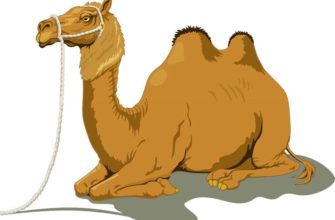 First you need to understand for yourself what is the wind. The scientific definition is quite voluminous, in a minimized form it sounds something like this: "The movement of air masses between zones of different pressures." But such a wording will say little to the child. Visibility is the most effective way to explain something. So, we will consider several ways to visually explain the nature of the wind.
First you need to understand for yourself what is the wind. The scientific definition is quite voluminous, in a minimized form it sounds something like this: "The movement of air masses between zones of different pressures." But such a wording will say little to the child. Visibility is the most effective way to explain something. So, we will consider several ways to visually explain the nature of the wind.
Method number 1: Cold weather and a candle
The main condition is the cold weather outside the window. In summer or spring you will have to use other methods. If a child suddenly asked, “Maaam, why is the wind blowing?”, Then we are not lost, but we take a candle and go to the door. We light the light and bring it to the upper crack of the ajar opening. We see that the flame tends to go outside, carried away by the stream of warm air. This is the wind that came out of the air heated in the house. Therefore first fact: heated air rises.
Then we lower the candle to the lower slit and see that the flame has changed its slope and is now directed inward. This happens because the cold air tends to take the place of the heated. Hence, second fact: cold air tends to take the place of warm. On this, the practical part can be completed. And go to the theoretical explanation that the globe has warm places (like in a house) and cold places (like in a street). The movement of air between them leads to the appearance of wind.
Method number 2: Balloon, hairdryer and refrigerator
For the next way to clearly explain the nature of the wind, you will need to prepare a balloon. Inflate it not completely. Take a hair dryer and blow it well. The ball increases in volume and begins to soar. In this example, we explain to the child that the heated air tends to rise as high as possible.
Then put the ball in the refrigerator. While it cools down there, we talk about how the globe is so large that when it is warm in one place, it is cold in another. Then we open the refrigerator and see that the cold ball cringes and quickly falls down.
After the practical part, we proceed to explain that cold air tends to take the place of warm air, which is why the wind turns out. That is, the wind is nothing more than the movement of air between cold and warm places.
Method number 3: Metaphorical
Instead of visualization, you can use metaphors from the environment. Imagine that the dad who took the computer to work and does not allow watching cartoons is one mass of air. And the child who eagerly eats in anticipation of the next episode is another.
Here the mass dad sits, works and slowly heats up. And when it is completely heated, it rises from the chair and goes, say, to the kitchen. Now he is the warm air that rose high and flew away. The kid in this case, the air is cold, which instantly rushed into a chair in front of the monitor. This movement of him is the wind.
Method number 4: Physiological
Another explanation is based on lung function. When a child is interested in the nature of the wind, we ask him to take in more air and then slowly blow it out. This will be the wind. Air in the contracting lungs is pressurized and exits. So it is with the wind.
A small theoretical digression that warm air is lighter than cold will simplify the explanation. Heavy cold air creates the same pressure as the walls of the lungs. From this, cold air moves to where it was warm. So the wind turns out.
Surprises and surprises
In the mind of a growing child, such a lesson will give rise to another million questions: “What kind of wind is there?”, “Why is it needed?”, “And if it is strong, strong?”. In fact, in order to answer these questions, you will need to shovel volumes of meteorological manuals and get five or two higher educations. But the child can be explained in a nutshell.
Why do we need wind? To keep it cool and to blow away dandelions. What is the wind? Strong, weak, blowing in different directions, and whole air rivers flow high above the ground. And in that spirit. It is not necessary to spread, it is enough not to leave spaces in the mind of the baby, which subsequently can be filled with what is not necessary.
We also read:
Here's what the forums write:
Trackstone:There are places on our planet where it is warmer and where it is colder. The sun warmed the desert, and the air warmed along with it. When heated, objects expand, air is no exception. The air warmed and expanded. And over the desert the hump of heated air swelled (pressure increased) clouds from the middle of such a hump flow to the edges, and in the center of it it is always clear that such humps (high pressure areas) are called anticyclones.
And in another place the clouds covered the Sun, it became colder, the air contracted. And from this a pit (low pressure area) was formed. Clouds flow to this place; it usually rains there. The low pressure area is called a cyclone.
And what will happen if a cyclone and an anticyclone meet? A desert near the sea, for example?
If they meet the air from the "hump" begins to flow into the "cavity", a strong wind blows. This venue is called the atmospheric front.
But the wind also blows inside the "humps and troughs." Remember how the water in the bath swirls when it drains into a hole? That's right, she twists into a funnel. In the same way, the air draining from the hump swirls, and flowing into the center of the pit, too, only in the other direction. This twisting also causes wind inside the cyclone and anticyclone.
You will tell about breezes. In the morning the earth heats up - in the afternoon the wind blows from the sea. In the evening, the sea gives up the accumulated heat, and the earth cools - the wind blows from the shore.DmHaritonov:From one side the sun warms the Earth more strongly, there the air expands, and climbs from there to other lands. Here is the wind.
http://www.bolshoyvopros.ru/questions/704094-otchego-duet-veter-kak-objasnit-rebenku-dostupno.html
Recommended book: Why is the wind blowing? 40 experiments, experiments, amazing facts for children from 5 to 7 years old (Authors: Vasily Romodin, Marina Romodina).
Open this book, and you will understand where the clouds come from and why the rainbow shines in the sky, why the leaves turn yellow, and why in the fall the birds fly south. You will learn to distinguish trees by leaves and learn how plants “drink”. This book will give answers to dozens of “why” and help to link together various natural phenomena. Entertaining experiments and experiments will help you “see” the sound, “make a cloud” in the jar, grow crystals from salt and a tulip by March 8, find out how much water will come from a glass of snow and how the earthworm mixes the soil.












Oh, all these conversations are yet to come and I hope that I will not have any problems in order to explain to the child what’s what. But still, I am afraid of these issues.
The most difficult part in such conversations is that it’s rather difficult to think of how to explain the scientific facts to the child in the form of a fairy tale so that he understands everything.
We are now at the very age when it is time to ask questions. I am not afraid of these questions and I am sure that I can explain to my child why our world is so arranged.
In fact, you should not be afraid of such issues, because there is nothing complicated in them. The main thing is to be able to fantasize and then it will turn out to easily turn scientific facts into a fairy tale.